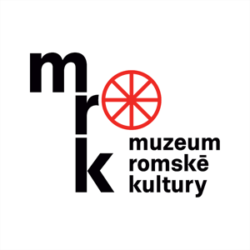Jan Ištván (1921)
Jan Ištván (1921, Letovice, okres Blansko – year of death unknown)
-
Testimony abstract
Jan Ištván was born in the village of Letovice near Kunštát. His father Antonín Josef Ištván worked as a knife grinder and umbrella maker. His mother, Marie Jana Ištvánová, peddled curtains and lace, which she used to buy at a workshop in the chateau in Letovice. The family lived in two vovered wagons, in which they travelled around the villages from Boskovice to Kunštát. They always stayed in one of the larger villages for two to four weeks while his father plied his trade. The height of the wagons was seven and five metres, both richly decorated with carvings and colourful paintings. Ištván recalls that they were not poverty-stricken and did not have to go begging like some of the other Roma; they lived contentedly.
When Jan Ištván started school, the family settled in Kunštát, where his father had right of abode. They lived in two interconnected and well furnished covered wagons. His brothers Josef and Bohouš worked in the carting business there. Jan Ištván worked for the Schmidt company, for which he built the road and bridge in Kunštát. The Germans registered the family [after the occupation] in 1939. In the autumn of that year, Kohn, a local Jewish textile merchant, warned Jan Ištván's father that “things were bad" and that they should flee. He said the merchant himself fled, but the Ištvan family did not know where to go, so they stayed. Until 1942 they lived relatively peacefully, although they were registered as a Roma family. It was not until August 1942 that the gendarmes arrived, took note of everything and went away again.[1] Then they came again and the situation repeated itself, and they were told to pack up, as they were to be evicted. The third time the gendarmes arrived with vehicles and took them to Hodonín [to the camp].[2]
On arrival at the camp they had to wash and were assigned accommodation. Food was scarce. For the first month or two they had enough rations, but later they were often hungry. For breakfast they were given rye coffee and a piece of bread; the main meal was a stew that they called žula. The conditions in the camp gradually deteriorated, and various infections began to spread among the prisoners, although a doctor who was "half German half Czech" came to the camp.[3] There were attempts to escape. Pepík (i.e. Josef) Daniel and some others tried to escape, but failed. They were caught and punished by being beaten and placed in solitary confinement.[4] The first prisoners who died were buried in the cemetery at Černovice. Jan Ištván remembered a Romani woman who died of pneumonia. She was taken in a coffin by horse-drawn carriage to Černovice. Later on, however, [after the typhus epidemic broke out] they banned the burial of prisoners from the camp, and a burial site was created in the forest near the camp [known as Žalov]. The gendarmes and the gamekeeper chose a place in the forest, and the prisoners, among them Ján Ištván, cut down trees, dug a pit, and enclosed the site with a wire fence.
Even teenage children had to work in the camp; boys between the ages of twelve and fourteen went to the village where a stream was being culverted. Everyone had to work, regardless of the weather. When the older gendarmes were supervising, they were allowed to rest occasionally, but the young gendarmes were strict. Jan Ištván worked in a quarry where they broke stone for road building, and sometimes the gendarmes chose him to help them reload some goods from the train. After Christmas [1942], he went for this purpose with two other prisoners and two Czech gendarmes to the station at Nedvědice and then on to the station at Tišnov, where they remained unattended for a while. Jan Ištván took the opportunity to escape. He reached Lipůvka in the snow and frost. He stopped in front of a local pub, but did not enter it because he had no money.[5] He was approached by an elderly man with a cart, probably a carter or a peasant, who asked him if he was hungry and bought him soup and bread. Ištván spent the night in the woods above Lipůvka.
He set out for Brno to look for friends from the Daniel or Junek families, but they had all been interned, so he headed to Vyškov to find the Bystřický family. On his way he tried to be inconspicuous, hiding in the woods during the day. At that time, the Bystřický family lived in the local Jewish cemetery. [Martin] Bystřický worked as a carter and had three children, Jan, Tonda and Alena, aged between six and eight. He hid Jan Ištván in his home. After a few weeks, Bystřický met a local plainclothes gendarme who warned him that they were going to be taken away, and advised him to flee. So the family and Ištván quickly set off for Slovakia, where they hoped conditions would be better. It was February, Ištván carried little Tonda Bystřický on his back, and they spent the night in the woods. All the time Ištván had his “Kennkarte” identity document with him; it was not been taken away from him even in the camp. Bystřický's wife, Richtrová[6] had one too, so they went together to buy food in the village near to where they were spending the night. When they were cooking the potatoes they had bought in the forest, two German gendarmes and another six or seven persons in civilian clothes appeared. They were all arrested and taken to a barn in the village. The next day they were taken to the prison in Zdounky. After a few weeks, they were transferred from there to the workhouse in Brno.[7] Ištván was there with his future wife Božena and her then pregnant sister Antonia Vrbová (née Bystřická). They were released in Brno. Ištván believed that their release may have been related to Antonie Vrbová's pregnancy. They subsequently returned to Vyškov, but not back to the Jewish cemetery; they found housing in nearby Nosalovice, where Ištván later worked as a carter.
- [1] It was probably a so-called inventory of "gypsies, gypsy miscegenates and persons roaming in the gypsy manner", and its implementation date was 2 August 1942.
- [2] 3 August 1942. (ed.)
- [3] Medical services in the camp were provided by Dr. Josef Habanec, a doctor from Olešnice, who came to the camp once every 14 days to examine and check the prisoners. After the outbreak of the typhus epidemic, a Jewish doctor, Alfred Mílek, who spoke fluent Czech and German, was called to the camp. (ed.)
- [4] Of the prisoners named Josef Daniel listed in Nečas's published records, only Josef (Lala) Daniel (born 1907, Oslavany) escaped on 19 December 1942 and again on 28 March 1943. Each time he was caught and returned. On 21 August 1943, he was deported to Auschwitz II-Birkenau. (ed.)
- [5] The Formanka pub, whose history dates back to 1894, is still in operation today. It is located on the Brno road; Lipůvka (Blansko district) is about 30 km from Hodonín. (ed.)
- [6] First name not given.
- [7] Now known as Káznice, the former penitentiary at Cejl in Brno. (ed.)
None of Jan Ištván's family survived the war. His father died at the Hodonín camp, and his mother and six siblings were deported to Auschwitz II-Birkenau.
-
Origin of Testimony
Jan Ištvan's testimony is quoted from an interview conducted by the Museum of Romani Culture in Brno in Prague on 7 February 2006 in cooperation with the Živá paměť organization. Other source material includes two interviews from 2006: Výzkumná zpráva 9/2006 projekt o. p. s. Živá paměť a MRK – Výzkum a dokumentace holocaustu Romů v době 2. světové války, and the article by Jana Horváthová and Michal Schuster “Jan Ištván. Celkově před tou válkou nám nic nechybělo…”, published in the Bulletin Muzea romské kultury No. 15 (2006, pp. 42–46).




